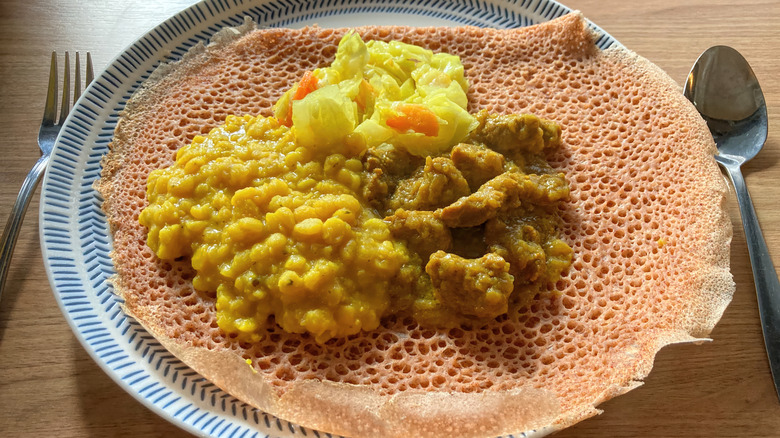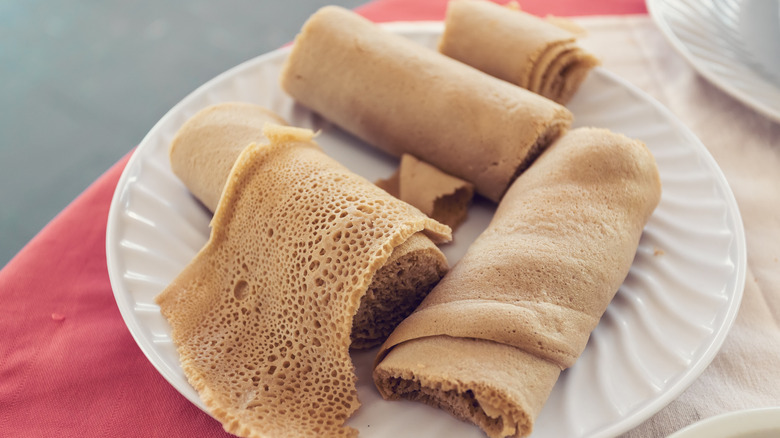An Underrated Bread Is Made With A Flour That's Packed With Protein
Bread has been a staple on dinner tables for millennia, symbolizing sustenance, tradition, and community. The act of breaking bread with others evokes a sense of unity as people come together to share the harvest of their grains. Yet bread has become a villain in the eyes of many low-carb enthusiasts. Some of that can be blamed on highly processed bread that's made with refined flour. When flour is refined, it's been stripped of the fiber that can slow down your blood sugar response. A slice of white bread has less than a gram of fiber. (Here are 14 whole grains you should be eating.)
One type of bread that remains uncommon on American tables is Ethiopian injera. This spongy, crepe-like flatbread is made from teff flour, an ancient grain naturally rich in fiber and protein. A 12-inch serving of injera provides 112 calories, 3 grams of fiber, and 4 grams of protein. Unlike many conventional breads, injera is both gluten-free and a naturally fermented food, much like sourdough. Injera is a nutritional powerhouse that can be a more wholesome alternative to refined grain options.
Injera bread's teff and fermentation make it more nutritious
Swapping out wheat for teff in your bread could be a smart move for your health. A 2020 review in the Journal of Food Quality highlighted teff as a solid plant-based protein source. Teff has an impressive amount of the essential amino acid lysine compared to other grains. Injera bread made with teff is a great option for those with celiac disease or gluten sensitivities.
Unlike typical breads, traditional injera doesn't use store-bought yeast. Instead, the natural yeast and lactic acid bacteria in teff flour are left to work their magic for a few days. As the dough ferments, the batter becomes more acidic, which helps reduce harmful bacteria, according to a 2020 article in the Journal of Ethnic Foods.
Teff also comes packed with essential minerals like iron, calcium, and zinc. However, these nutrients can be tricky for your body to absorb due to the grain's natural phytic acid. The fermentation process helps break down that phytic acid, boosting the bioavailability of these important minerals and improving nutrient absorption. Teff is rich in phenolic compounds and flavonoids, which help protect your cells from damage caused by free radicals. Fermenting the dough for at least 18 hours can significantly increase these antioxidants, giving your body an extra dose of nutritional goodness with every bite of that delicious, tangy injera.
How to make homemade injera bread
You might find fresh Ethiopian injera bread at some specialty stores, but you can easily make it at home. Teff flour tends to be a little pricier than other types of flour, which is why you'll sometimes see injera bread made with a blend of teff, wheat, sorghum, or maize. If you want the full nutritional power of injera bread, stick with teff flour.
Begin by mixing one cup of teff flour with 12 ounces of warm water in a bowl. Cover the mixture with a breathable cloth (a dish towel works well) and let it sit at room temperature for at least 18 hours, or up to 48 hours. By the end of the fermentation period, there should be some liquid on top. Don't stir this liquid back into the teff; carefully pour it off instead.
Unlike sourdough, which forms a ball of dough, injera batter has a pancake-like consistency. If you want thinner injera bread, add a little more water. Baking soda can help reduce the sourness of the batter, and you can also add a bit of salt for flavor.
Preheat a skillet and add a small amount of cooking oil. Pour about half a cup of batter into the pan, just enough to coat the surface. Cover the pan and let the batter cook for a few minutes. The injera bread is ready when bubbles form and the surface looks dry. Gently remove the bread from the pan and repeat with the remaining batter.



